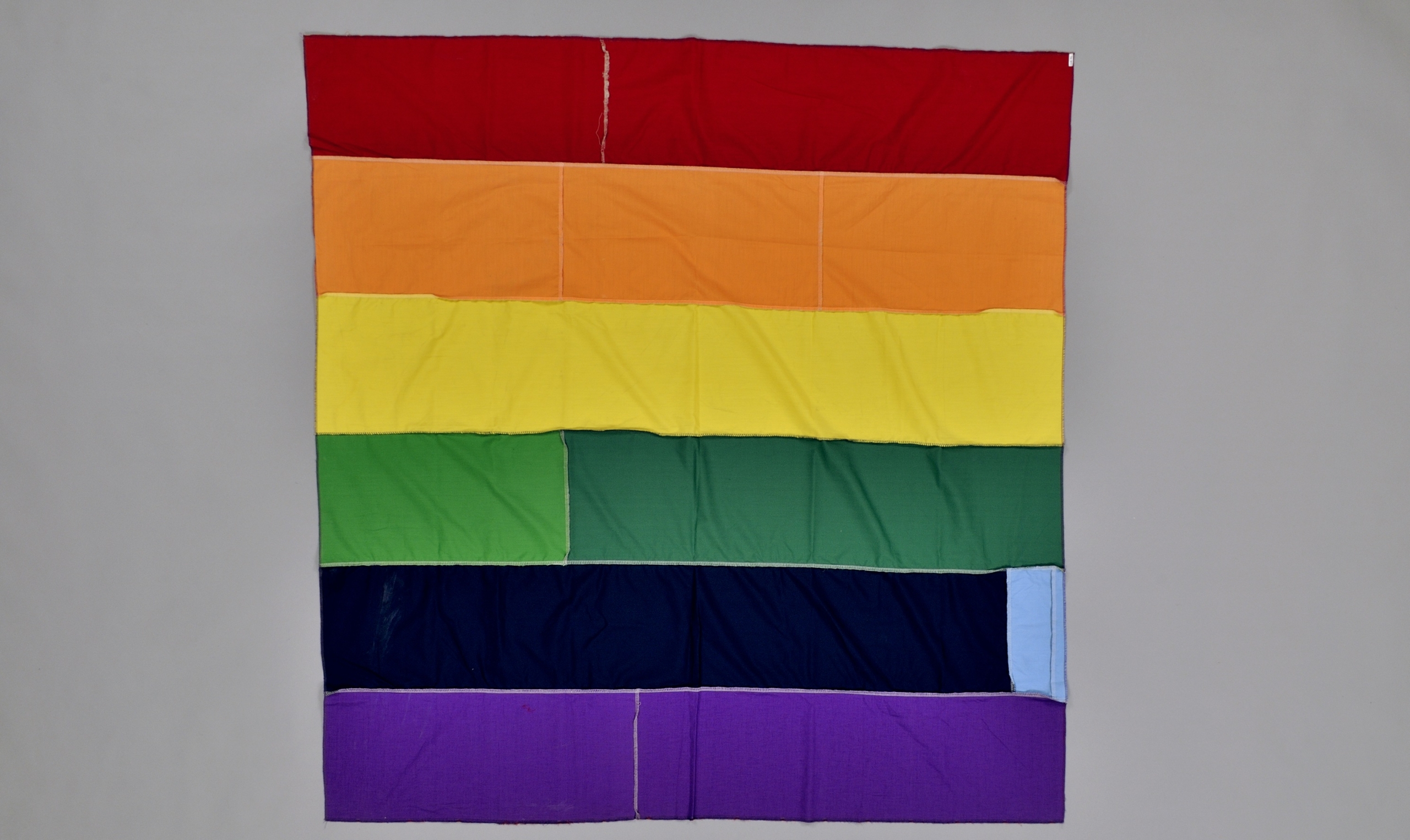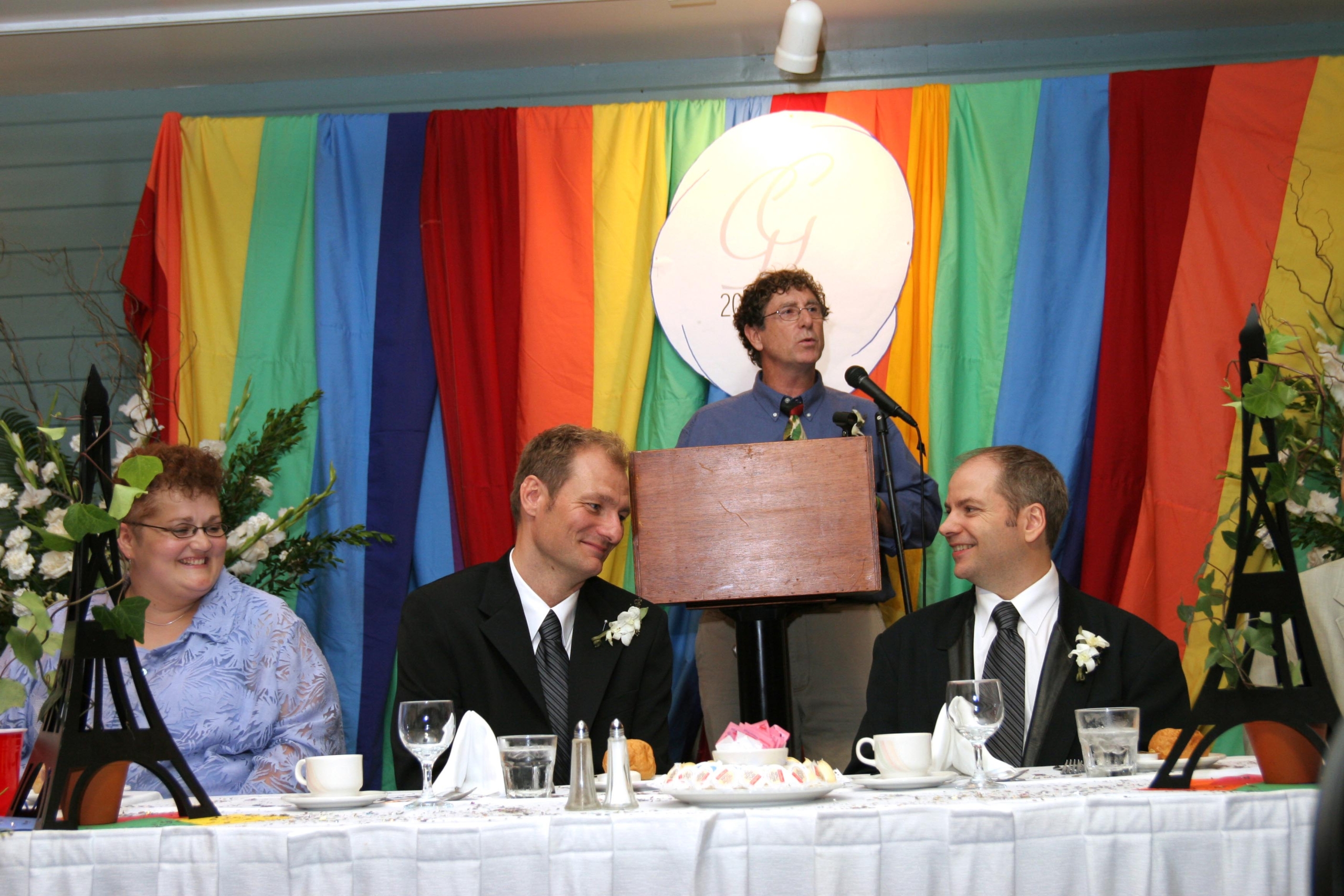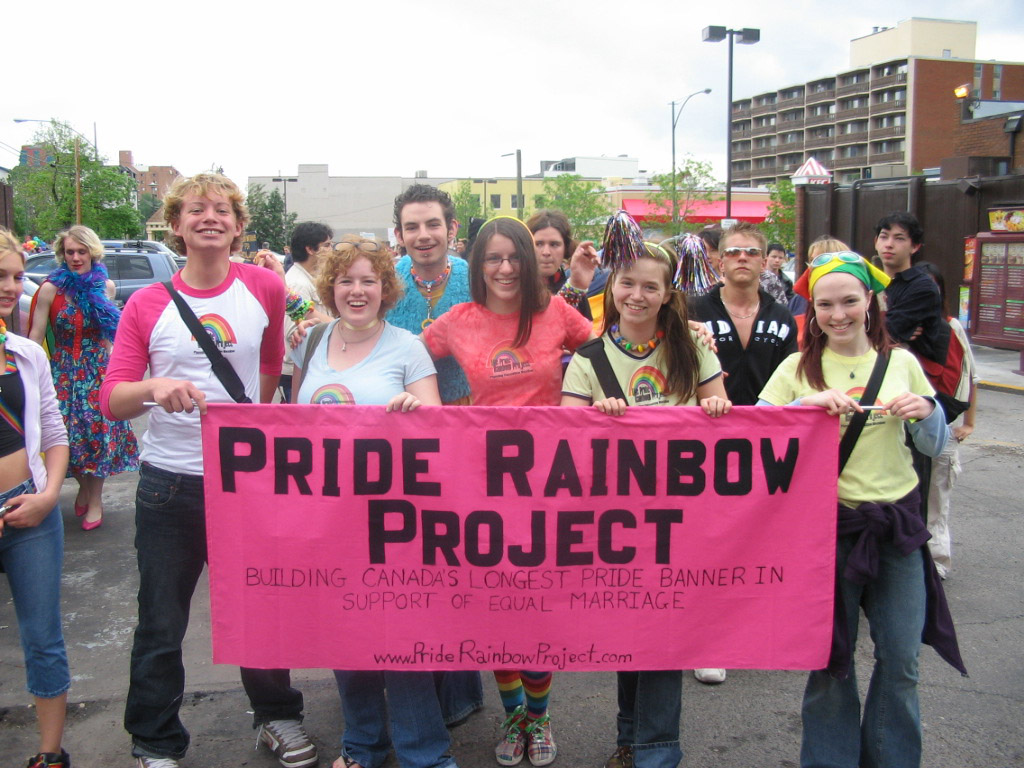Pride Banner
Artifact
Image
Video
Audio
 Activities
Activities
LOOK
Look at this object. What do you think it is? What do you think it symbolizes?
THINK
The rainbow is an important symbol for the LGBTQ2SI+ community. What other symbols do you encounter in your daily life?
Hint: Think about flags, colours, shapes and words that represent groups or movements.
Details
 Materials
Materials - Cotton
- Polyester
Historical Context
Choose one of the three levels below to match your needs.
- This is a segment of a 150-metre rainbow banner made in 2005 by a Unitarian Church youth group in Calgary, Alberta, to show support for equal (same-sex) marriage.
- Following a rally in Ottawa, it was cut into sections and given to community members. Gilles Marchildon and Gord Klassen used a piece of the banner during their 2005 wedding celebrations.
- Following court decisions and intense public debate, the federal government passed the Civil Marriage Act in July 2005, making Canada the fourth country in the world to legalize equal (same-sex) marriage.
Scroll through the media carousel above to see a photo from Gilles Marchildon and Gord Klassen’s wedding, and a photo of the Pride Rainbow Project.
This is a segment of a 150-metre rainbow banner made in 2005 by a Unitarian Church youth group in Calgary, Alberta, to show support for equal (same-sex) marriage.
Following a rally in Ottawa, it was cut into sections and given to community members. Gilles Marchildon and Gord Klassen used a piece of the banner during their 2005 wedding celebrations.
After years of grassroots appeals for equal access to civil institutions, including marriage, the LGBTQ2SI+ community won a series of victories in Canadian courts in the 1990s. Many saw the right to marry as integral to a public acknowledgement of equality. Following court decisions and intense public debate, the federal government passed the Civil Marriage Act in July 2005, making Canada the fourth country in the world to legalize same-sex (equal) marriage.
This is a segment of a 150-metre rainbow banner made in 2005 by Sanford Kome-Pond, Cora Bailey, Emily Johnson, Erin James and Christine Michell. They created the banner through their Unitarian Church youth group in Calgary, Alberta, to show support for equal (same-sex) marriage.
They brought the banner to Ottawa for a Parliament Hill rally in support of equal-marriage legislation. Following the rally, the banner was cut into sections and passed out to members of the LGBTQ2SI+ community. Gilles Marchildon and Gord Klassen used a piece of the banner during their 2005 wedding celebrations in Ottawa.
The rainbow had a long history as a symbol within the community, before rainbow flags became popular in marches and rallies in the late 1970s. In the years following the Second World War, LGBTQ2SI+ Canadians began fighting for equality both under the law and in social attitudes on a number of fronts.
In the 1990s, after years of grassroots appeals for equal access to civil institutions, including marriage, the LGBTQ2SI+ community won a series of victories in Canadian courts. Many saw the right to marry as integral to a public acknowledgement of equality.
Following court decisions and intense public debate, the federal government passed the Civil Marriage Act in July 2005, making Canada the fourth country in the world to legalize equal (same-sex) marriage.
- This is a segment of a 150-metre rainbow banner made in 2005 by a Unitarian Church youth group in Calgary, Alberta, to show support for equal (same-sex) marriage.
- Following a rally in Ottawa, it was cut into sections and given to community members. Gilles Marchildon and Gord Klassen used a piece of the banner during their 2005 wedding celebrations.
- Following court decisions and intense public debate, the federal government passed the Civil Marriage Act in July 2005, making Canada the fourth country in the world to legalize equal (same-sex) marriage.
Scroll through the media carousel above to see a photo from Gilles Marchildon and Gord Klassen’s wedding, and a photo of the Pride Rainbow Project.
This is a segment of a 150-metre rainbow banner made in 2005 by a Unitarian Church youth group in Calgary, Alberta, to show support for equal (same-sex) marriage.
Following a rally in Ottawa, it was cut into sections and given to community members. Gilles Marchildon and Gord Klassen used a piece of the banner during their 2005 wedding celebrations.
After years of grassroots appeals for equal access to civil institutions, including marriage, the LGBTQ2SI+ community won a series of victories in Canadian courts in the 1990s. Many saw the right to marry as integral to a public acknowledgement of equality. Following court decisions and intense public debate, the federal government passed the Civil Marriage Act in July 2005, making Canada the fourth country in the world to legalize same-sex (equal) marriage.
This is a segment of a 150-metre rainbow banner made in 2005 by Sanford Kome-Pond, Cora Bailey, Emily Johnson, Erin James and Christine Michell. They created the banner through their Unitarian Church youth group in Calgary, Alberta, to show support for equal (same-sex) marriage.
They brought the banner to Ottawa for a Parliament Hill rally in support of equal-marriage legislation. Following the rally, the banner was cut into sections and passed out to members of the LGBTQ2SI+ community. Gilles Marchildon and Gord Klassen used a piece of the banner during their 2005 wedding celebrations in Ottawa.
The rainbow had a long history as a symbol within the community, before rainbow flags became popular in marches and rallies in the late 1970s. In the years following the Second World War, LGBTQ2SI+ Canadians began fighting for equality both under the law and in social attitudes on a number of fronts.
In the 1990s, after years of grassroots appeals for equal access to civil institutions, including marriage, the LGBTQ2SI+ community won a series of victories in Canadian courts. Many saw the right to marry as integral to a public acknowledgement of equality.
Following court decisions and intense public debate, the federal government passed the Civil Marriage Act in July 2005, making Canada the fourth country in the world to legalize equal (same-sex) marriage.
Summary
- This is a segment of a 150-metre rainbow banner made in 2005 by a Unitarian Church youth group in Calgary, Alberta, to show support for equal (same-sex) marriage.
- Following a rally in Ottawa, it was cut into sections and given to community members. Gilles Marchildon and Gord Klassen used a piece of the banner during their 2005 wedding celebrations.
- Following court decisions and intense public debate, the federal government passed the Civil Marriage Act in July 2005, making Canada the fourth country in the world to legalize equal (same-sex) marriage.
Scroll through the media carousel above to see a photo from Gilles Marchildon and Gord Klassen’s wedding, and a photo of the Pride Rainbow Project.
Essential
This is a segment of a 150-metre rainbow banner made in 2005 by a Unitarian Church youth group in Calgary, Alberta, to show support for equal (same-sex) marriage.
Following a rally in Ottawa, it was cut into sections and given to community members. Gilles Marchildon and Gord Klassen used a piece of the banner during their 2005 wedding celebrations.
After years of grassroots appeals for equal access to civil institutions, including marriage, the LGBTQ2SI+ community won a series of victories in Canadian courts in the 1990s. Many saw the right to marry as integral to a public acknowledgement of equality. Following court decisions and intense public debate, the federal government passed the Civil Marriage Act in July 2005, making Canada the fourth country in the world to legalize same-sex (equal) marriage.
In-Depth
This is a segment of a 150-metre rainbow banner made in 2005 by Sanford Kome-Pond, Cora Bailey, Emily Johnson, Erin James and Christine Michell. They created the banner through their Unitarian Church youth group in Calgary, Alberta, to show support for equal (same-sex) marriage.
They brought the banner to Ottawa for a Parliament Hill rally in support of equal-marriage legislation. Following the rally, the banner was cut into sections and passed out to members of the LGBTQ2SI+ community. Gilles Marchildon and Gord Klassen used a piece of the banner during their 2005 wedding celebrations in Ottawa.
The rainbow had a long history as a symbol within the community, before rainbow flags became popular in marches and rallies in the late 1970s. In the years following the Second World War, LGBTQ2SI+ Canadians began fighting for equality both under the law and in social attitudes on a number of fronts.
In the 1990s, after years of grassroots appeals for equal access to civil institutions, including marriage, the LGBTQ2SI+ community won a series of victories in Canadian courts. Many saw the right to marry as integral to a public acknowledgement of equality.
Following court decisions and intense public debate, the federal government passed the Civil Marriage Act in July 2005, making Canada the fourth country in the world to legalize equal (same-sex) marriage.



